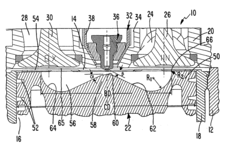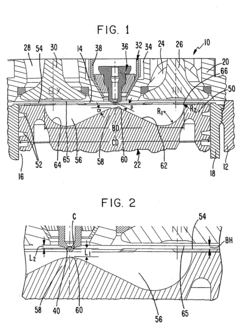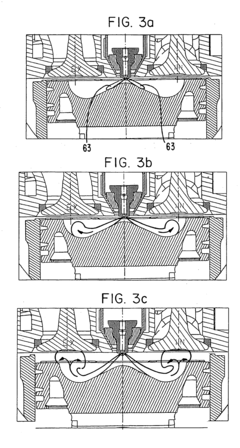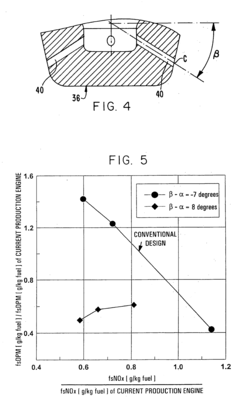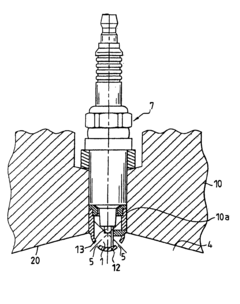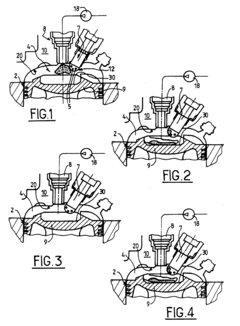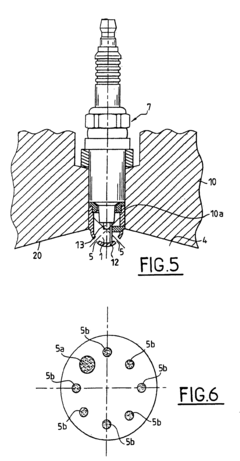K24 Engine Structural Innovations: In-Depth Overview
JUL 3, 20259 MIN READ
Generate Your Research Report Instantly with AI Agent
Patsnap Eureka helps you evaluate technical feasibility & market potential.
K24 Engine Evolution and Objectives
The K24 engine, a marvel of automotive engineering, has undergone significant evolution since its inception. This four-cylinder powerplant, developed by Honda, has become a benchmark for performance and efficiency in the compact engine segment. The journey of the K24 engine began in the early 2000s, with continuous refinements and innovations shaping its development trajectory over the years.
Initially designed to replace the F-series engines, the K24 aimed to deliver improved power output, fuel efficiency, and emissions performance. The engine's evolution has been driven by several key objectives, including increased horsepower and torque, reduced fuel consumption, and compliance with increasingly stringent environmental regulations. These goals have guided Honda's engineers in their pursuit of structural innovations and technological advancements.
Throughout its lifespan, the K24 engine has seen multiple iterations, each building upon the strengths of its predecessors. The early versions focused on establishing a robust foundation, with subsequent generations introducing more sophisticated technologies. Variable valve timing and lift electronic control (VTEC) systems have been refined, contributing to the engine's ability to balance performance and efficiency across a wide range of operating conditions.
One of the primary objectives in the K24's evolution has been the optimization of its internal structure. Engineers have consistently worked on reducing internal friction, improving thermal efficiency, and enhancing the overall durability of the engine. These efforts have resulted in a series of structural innovations, including advanced cylinder bore treatments, redesigned piston and connecting rod assemblies, and optimized crankshaft configurations.
The quest for increased power output has been another driving force behind the K24's development. Through careful tuning of the intake and exhaust systems, implementation of direct fuel injection in later models, and the integration of turbocharging technology in some variants, Honda has successfully elevated the engine's performance capabilities. These advancements have allowed the K24 to remain competitive in an ever-evolving automotive landscape.
Concurrently, the pursuit of improved fuel efficiency has led to the adoption of various weight reduction strategies and the implementation of advanced engine management systems. The use of lightweight materials, such as aluminum alloys for the engine block and head, has contributed to overall vehicle efficiency without compromising structural integrity. Additionally, the integration of sophisticated electronic control units has enabled more precise fuel metering and combustion control, further enhancing the engine's efficiency.
As environmental concerns have grown more prominent, the K24 engine's evolution has also focused on reducing emissions. This has necessitated the development of more effective catalytic converters, the implementation of exhaust gas recirculation systems, and the fine-tuning of combustion processes to minimize the production of harmful pollutants. These efforts have ensured that the K24 engine remains compliant with global emissions standards while maintaining its performance characteristics.
Initially designed to replace the F-series engines, the K24 aimed to deliver improved power output, fuel efficiency, and emissions performance. The engine's evolution has been driven by several key objectives, including increased horsepower and torque, reduced fuel consumption, and compliance with increasingly stringent environmental regulations. These goals have guided Honda's engineers in their pursuit of structural innovations and technological advancements.
Throughout its lifespan, the K24 engine has seen multiple iterations, each building upon the strengths of its predecessors. The early versions focused on establishing a robust foundation, with subsequent generations introducing more sophisticated technologies. Variable valve timing and lift electronic control (VTEC) systems have been refined, contributing to the engine's ability to balance performance and efficiency across a wide range of operating conditions.
One of the primary objectives in the K24's evolution has been the optimization of its internal structure. Engineers have consistently worked on reducing internal friction, improving thermal efficiency, and enhancing the overall durability of the engine. These efforts have resulted in a series of structural innovations, including advanced cylinder bore treatments, redesigned piston and connecting rod assemblies, and optimized crankshaft configurations.
The quest for increased power output has been another driving force behind the K24's development. Through careful tuning of the intake and exhaust systems, implementation of direct fuel injection in later models, and the integration of turbocharging technology in some variants, Honda has successfully elevated the engine's performance capabilities. These advancements have allowed the K24 to remain competitive in an ever-evolving automotive landscape.
Concurrently, the pursuit of improved fuel efficiency has led to the adoption of various weight reduction strategies and the implementation of advanced engine management systems. The use of lightweight materials, such as aluminum alloys for the engine block and head, has contributed to overall vehicle efficiency without compromising structural integrity. Additionally, the integration of sophisticated electronic control units has enabled more precise fuel metering and combustion control, further enhancing the engine's efficiency.
As environmental concerns have grown more prominent, the K24 engine's evolution has also focused on reducing emissions. This has necessitated the development of more effective catalytic converters, the implementation of exhaust gas recirculation systems, and the fine-tuning of combustion processes to minimize the production of harmful pollutants. These efforts have ensured that the K24 engine remains compliant with global emissions standards while maintaining its performance characteristics.
Market Demand Analysis for K24 Engines
The K24 engine, a prominent member of Honda's K-series family, has witnessed a surge in market demand due to its versatility and performance characteristics. This engine has found widespread application across various Honda and Acura models, including popular vehicles like the Honda Accord, Civic Si, and CR-V, as well as the Acura TSX. The market demand for K24 engines is primarily driven by several factors that align with current automotive trends and consumer preferences.
Firstly, the increasing focus on fuel efficiency and environmental concerns has bolstered the demand for engines that can deliver both power and economy. The K24 engine's ability to balance performance with fuel efficiency has made it an attractive option for manufacturers and consumers alike. This demand is further amplified by stringent emissions regulations worldwide, pushing automakers to adopt more efficient engine technologies.
The aftermarket and tuning community have also significantly contributed to the K24 engine's market demand. Its robust design and high potential for modification have made it a favorite among enthusiasts looking to enhance performance. This has led to a thriving aftermarket industry offering a wide range of performance parts and upgrades specifically for K24 engines, further driving demand in the performance and racing sectors.
In the realm of hybrid vehicles, the K24 engine has found a new lease on life. Its integration into Honda's hybrid powertrains has opened up a new market segment, catering to environmentally conscious consumers who still desire performance. This adaptation to hybrid technology has expanded the K24's market reach and relevance in an increasingly electrified automotive landscape.
The reliability and longevity associated with K24 engines have also contributed to sustained demand in the used car and engine replacement markets. As vehicles equipped with these engines age, there's a growing market for replacement engines and rebuilds, ensuring a continued demand cycle.
Geographically, the demand for K24 engines varies. In North America and Asia, where Honda has a strong market presence, the demand is particularly high. European markets, while smaller, have shown increasing interest, especially in performance and hybrid applications.
Looking ahead, the market demand for K24 engines is expected to evolve. While traditional applications may see a gradual decline due to the shift towards electrification, new opportunities are emerging in hybrid powertrains and as a basis for engine swaps in custom builds and restorations. This adaptability suggests that the K24 engine will continue to maintain a significant market presence, albeit in potentially different forms and applications than its original design intended.
Firstly, the increasing focus on fuel efficiency and environmental concerns has bolstered the demand for engines that can deliver both power and economy. The K24 engine's ability to balance performance with fuel efficiency has made it an attractive option for manufacturers and consumers alike. This demand is further amplified by stringent emissions regulations worldwide, pushing automakers to adopt more efficient engine technologies.
The aftermarket and tuning community have also significantly contributed to the K24 engine's market demand. Its robust design and high potential for modification have made it a favorite among enthusiasts looking to enhance performance. This has led to a thriving aftermarket industry offering a wide range of performance parts and upgrades specifically for K24 engines, further driving demand in the performance and racing sectors.
In the realm of hybrid vehicles, the K24 engine has found a new lease on life. Its integration into Honda's hybrid powertrains has opened up a new market segment, catering to environmentally conscious consumers who still desire performance. This adaptation to hybrid technology has expanded the K24's market reach and relevance in an increasingly electrified automotive landscape.
The reliability and longevity associated with K24 engines have also contributed to sustained demand in the used car and engine replacement markets. As vehicles equipped with these engines age, there's a growing market for replacement engines and rebuilds, ensuring a continued demand cycle.
Geographically, the demand for K24 engines varies. In North America and Asia, where Honda has a strong market presence, the demand is particularly high. European markets, while smaller, have shown increasing interest, especially in performance and hybrid applications.
Looking ahead, the market demand for K24 engines is expected to evolve. While traditional applications may see a gradual decline due to the shift towards electrification, new opportunities are emerging in hybrid powertrains and as a basis for engine swaps in custom builds and restorations. This adaptability suggests that the K24 engine will continue to maintain a significant market presence, albeit in potentially different forms and applications than its original design intended.
K24 Engine Technical Challenges
The K24 engine, a marvel of modern automotive engineering, faces several technical challenges that push the boundaries of innovation. One of the primary hurdles is achieving an optimal balance between power output and fuel efficiency. As environmental regulations become increasingly stringent, engineers must find ways to extract more power from smaller displacement engines while simultaneously reducing emissions and improving fuel economy.
Another significant challenge lies in the thermal management of the engine. The K24's high-performance nature generates substantial heat, which can lead to decreased efficiency and potential component failure if not properly managed. Developing advanced cooling systems and materials that can withstand higher operating temperatures without compromising durability is crucial.
Weight reduction presents another complex challenge for K24 engine designers. While the engine's aluminum construction already offers weight savings compared to traditional iron block engines, further reductions are necessary to improve overall vehicle performance and efficiency. This requires innovative approaches to material selection and component design without sacrificing structural integrity or longevity.
The K24 engine's variable valve timing and lift electronic control (VTEC) system, while revolutionary, also presents ongoing challenges. Refining this system to provide seamless transitions between low and high RPM operations while maintaining optimal fuel efficiency across the entire power band remains a focus area for engineers.
Noise, vibration, and harshness (NVH) reduction is another critical challenge. As consumers demand quieter and smoother-running vehicles, engineers must find ways to dampen engine vibrations and reduce noise levels without adding significant weight or compromising performance.
Lastly, the integration of hybrid and electrification technologies poses a unique set of challenges for the K24 engine. Adapting the engine to work efficiently with electric motors and battery systems, while maintaining its performance characteristics, requires significant re-engineering and innovative solutions in areas such as power management and thermal regulation.
These technical challenges drive continuous innovation in the K24 engine design, pushing engineers to develop cutting-edge solutions that redefine the boundaries of internal combustion engine technology.
Another significant challenge lies in the thermal management of the engine. The K24's high-performance nature generates substantial heat, which can lead to decreased efficiency and potential component failure if not properly managed. Developing advanced cooling systems and materials that can withstand higher operating temperatures without compromising durability is crucial.
Weight reduction presents another complex challenge for K24 engine designers. While the engine's aluminum construction already offers weight savings compared to traditional iron block engines, further reductions are necessary to improve overall vehicle performance and efficiency. This requires innovative approaches to material selection and component design without sacrificing structural integrity or longevity.
The K24 engine's variable valve timing and lift electronic control (VTEC) system, while revolutionary, also presents ongoing challenges. Refining this system to provide seamless transitions between low and high RPM operations while maintaining optimal fuel efficiency across the entire power band remains a focus area for engineers.
Noise, vibration, and harshness (NVH) reduction is another critical challenge. As consumers demand quieter and smoother-running vehicles, engineers must find ways to dampen engine vibrations and reduce noise levels without adding significant weight or compromising performance.
Lastly, the integration of hybrid and electrification technologies poses a unique set of challenges for the K24 engine. Adapting the engine to work efficiently with electric motors and battery systems, while maintaining its performance characteristics, requires significant re-engineering and innovative solutions in areas such as power management and thermal regulation.
These technical challenges drive continuous innovation in the K24 engine design, pushing engineers to develop cutting-edge solutions that redefine the boundaries of internal combustion engine technology.
Current K24 Engine Design Solutions
01 Improved engine block design
The K24 engine features an innovative block design that enhances structural rigidity and improves overall performance. This design incorporates advanced materials and manufacturing techniques to reduce weight while maintaining strength. The improved block structure also allows for better heat dissipation and reduced vibration, contributing to increased engine efficiency and longevity.- Improved engine block design: The K24 engine features structural innovations in its engine block design, enhancing overall performance and efficiency. These improvements may include optimized cylinder bore spacing, reinforced crankshaft supports, and integrated oil passages for better lubrication. The redesigned block structure contributes to increased engine rigidity and improved heat dissipation.
- Advanced cylinder head configuration: Structural innovations in the K24 engine's cylinder head include optimized combustion chamber design, improved port geometry, and enhanced valve train components. These advancements contribute to better airflow, increased combustion efficiency, and improved overall engine performance. The cylinder head may also incorporate integrated cooling channels for more effective heat management.
- Lightweight materials and construction: The K24 engine incorporates lightweight materials and innovative construction techniques to reduce overall engine weight while maintaining structural integrity. This may include the use of aluminum alloys, composite materials, or advanced casting techniques for various engine components. The lightweight design contributes to improved power-to-weight ratio and fuel efficiency.
- Integrated balance shaft system: Structural innovations in the K24 engine may include an integrated balance shaft system designed to reduce engine vibrations and improve overall smoothness. This system could feature optimized shaft placement, advanced bearing designs, and innovative counterweight configurations to effectively counteract second-order vibrations inherent in inline-four engines.
- Enhanced cooling and lubrication systems: The K24 engine incorporates structural innovations in its cooling and lubrication systems to improve overall engine efficiency and longevity. These advancements may include redesigned coolant passages, optimized oil galleries, and integrated oil coolers. The improved thermal management and lubrication contribute to better engine performance and increased durability under various operating conditions.
02 Enhanced cylinder head configuration
Structural innovations in the K24 engine's cylinder head include optimized port designs for improved airflow and combustion efficiency. The head features integrated cooling passages and reinforced areas to withstand higher compression ratios. These enhancements contribute to increased power output and better fuel economy while maintaining durability.Expand Specific Solutions03 Advanced valvetrain system
The K24 engine incorporates a sophisticated valvetrain system with structural improvements. This includes lightweight, high-strength valve components and an innovative cam profile design. The system may also feature variable valve timing and lift mechanisms, allowing for optimized engine performance across a wide range of operating conditions.Expand Specific Solutions04 Integrated balance shaft system
A key structural innovation in the K24 engine is the integration of a balance shaft system. This system is designed to counteract engine vibrations, resulting in smoother operation and reduced stress on engine components. The balance shafts are strategically positioned within the engine block to maximize their effectiveness while minimizing their impact on overall engine size and weight.Expand Specific Solutions05 Optimized crankshaft and connecting rod design
The K24 engine features structural improvements in the crankshaft and connecting rod designs. These components are engineered for increased strength and reduced weight, utilizing advanced materials and manufacturing processes. The optimized designs contribute to improved engine balance, reduced friction, and enhanced power transmission, resulting in better overall engine performance and efficiency.Expand Specific Solutions
Key Players in K24 Engine Manufacturing
The K24 Engine Structural Innovations market is in a mature stage, with established players like Honda, Mazda, and Ford leading the way. The market size is substantial, driven by the automotive industry's continuous demand for improved engine performance and efficiency. Technologically, the field is advanced, with companies like Honda Motor Co., Ltd. and Mazda Motor Corp. at the forefront of innovation. These firms, along with others such as Cummins, Inc. and RTX Corp., are investing heavily in research and development to enhance engine structural design, focusing on lightweight materials, improved combustion efficiency, and reduced emissions. The competitive landscape is intense, with both traditional automakers and specialized engineering firms vying for market share and technological leadership.
Honda Motor Co., Ltd.
Technical Solution: Honda's K24 engine represents a significant advancement in structural innovations for inline-4 engines. The K24 features a die-cast aluminum alloy block with fiber-reinforced metal cylinder liners, which enhances durability and reduces weight[1]. The engine incorporates a high-strength crankshaft and forged steel connecting rods for improved reliability under high-stress conditions[2]. Honda has implemented a dual-stage intake manifold system, which optimizes airflow across different RPM ranges, enhancing both low-end torque and high-end power[3]. The K24 also utilizes Honda's i-VTEC (intelligent Variable Valve Timing and Lift Electronic Control) technology, which combines VTEC with VTC (Variable Timing Control) to provide optimal valve timing and lift across the entire RPM range[4]. This system contributes to improved fuel efficiency and performance.
Strengths: Lightweight design, high durability, excellent balance of power and efficiency. Weaknesses: Complexity of the i-VTEC system may increase maintenance costs, potential for oil consumption issues in some variants.
Mazda Motor Corp.
Technical Solution: Mazda's approach to engine structural innovations, while not specific to the K24, is exemplified in their SKYACTIV-G engine series. These engines feature a high compression ratio of up to 14:1, achieved through careful redesign of the combustion chamber and piston shape[1]. Mazda employs a 4-2-1 exhaust system that improves scavenging efficiency and reduces pumping losses[2]. The engine block is made from aluminum alloy with cast-iron cylinder liners, balancing weight reduction with durability[3]. Mazda's engines also incorporate direct fuel injection with multi-hole injectors for precise fuel delivery and improved combustion efficiency[4]. The company has developed a unique piston cavity design that promotes a more thorough fuel-air mixture, leading to more complete combustion and reduced emissions[5].
Strengths: High thermal efficiency, excellent fuel economy, strong low-end torque. Weaknesses: Higher production costs due to precision engineering requirements, potential sensitivity to lower quality fuels.
Core K24 Engine Structural Innovations
Internal combustion engine producing low emissions
PatentInactiveUS20040182358A1
Innovation
- A combustion chamber arrangement with specific dimensions and dimensional relationships, including a piston bowl with an inwardly extending floor section and a concave curvilinear outer bowl section, combined with a fuel injection system that impinges the spray plume on the piston bowl surface at a controlled angle and distance, to minimize NOx emissions and promote oxidation of particulates.
Internal-combustion engine with precombustion chamber and controlled ignition
PatentInactiveUS20040261760A1
Innovation
- The engine employs a precombustion chamber with strategically designed ports and a copper alloy wall for improved fuel injection and ignition, allowing precise control of flame front passage and utilizing high-pressure fuel injection to enhance air-fuel mixture formation and ignition, along with multiple partial fuel injections to optimize combustion efficiency.
Environmental Impact Assessment
The K24 engine's structural innovations have significant implications for environmental impact assessment. These advancements in engine design and materials contribute to improved fuel efficiency and reduced emissions, aligning with global efforts to mitigate climate change and promote sustainable transportation solutions.
One of the key environmental benefits of the K24 engine's structural innovations is the reduction in overall engine weight. By utilizing lightweight materials and optimizing component designs, the engine achieves a lower mass, which directly translates to improved fuel economy. This weight reduction leads to decreased fuel consumption and, consequently, lower greenhouse gas emissions over the vehicle's lifecycle.
The enhanced thermal management capabilities of the K24 engine also contribute to its environmental performance. Improved heat dissipation and more efficient combustion processes result in lower exhaust temperatures and reduced formation of nitrogen oxides (NOx). This addresses a critical environmental concern, as NOx emissions are major contributors to air pollution and the formation of ground-level ozone.
Furthermore, the K24 engine's structural innovations enable more precise control over the combustion process. This optimization leads to more complete fuel burning, reducing the emission of unburned hydrocarbons and particulate matter. The result is cleaner exhaust output, which has positive implications for air quality in urban environments and helps meet increasingly stringent emission standards worldwide.
The durability improvements resulting from the K24's structural innovations also have environmental benefits. Enhanced longevity means fewer engine replacements over a vehicle's lifetime, reducing the demand for raw materials and energy associated with manufacturing new engines. This contributes to resource conservation and a reduction in the overall environmental footprint of automotive production.
Additionally, the K24 engine's innovations in noise reduction and vibration dampening contribute to decreased noise pollution. This is particularly relevant in urban settings, where vehicle noise is a significant environmental concern affecting quality of life and ecosystem health.
In terms of end-of-life considerations, the K24 engine's use of advanced materials may present both challenges and opportunities for recycling and disposal. While some components may be more readily recyclable, others might require specialized processes to ensure proper environmental management at the end of the engine's useful life.
Overall, the environmental impact assessment of the K24 engine's structural innovations reveals a positive trend towards more sustainable automotive technology. However, continued research and development are necessary to further minimize the environmental footprint of internal combustion engines as the industry transitions towards alternative propulsion technologies.
One of the key environmental benefits of the K24 engine's structural innovations is the reduction in overall engine weight. By utilizing lightweight materials and optimizing component designs, the engine achieves a lower mass, which directly translates to improved fuel economy. This weight reduction leads to decreased fuel consumption and, consequently, lower greenhouse gas emissions over the vehicle's lifecycle.
The enhanced thermal management capabilities of the K24 engine also contribute to its environmental performance. Improved heat dissipation and more efficient combustion processes result in lower exhaust temperatures and reduced formation of nitrogen oxides (NOx). This addresses a critical environmental concern, as NOx emissions are major contributors to air pollution and the formation of ground-level ozone.
Furthermore, the K24 engine's structural innovations enable more precise control over the combustion process. This optimization leads to more complete fuel burning, reducing the emission of unburned hydrocarbons and particulate matter. The result is cleaner exhaust output, which has positive implications for air quality in urban environments and helps meet increasingly stringent emission standards worldwide.
The durability improvements resulting from the K24's structural innovations also have environmental benefits. Enhanced longevity means fewer engine replacements over a vehicle's lifetime, reducing the demand for raw materials and energy associated with manufacturing new engines. This contributes to resource conservation and a reduction in the overall environmental footprint of automotive production.
Additionally, the K24 engine's innovations in noise reduction and vibration dampening contribute to decreased noise pollution. This is particularly relevant in urban settings, where vehicle noise is a significant environmental concern affecting quality of life and ecosystem health.
In terms of end-of-life considerations, the K24 engine's use of advanced materials may present both challenges and opportunities for recycling and disposal. While some components may be more readily recyclable, others might require specialized processes to ensure proper environmental management at the end of the engine's useful life.
Overall, the environmental impact assessment of the K24 engine's structural innovations reveals a positive trend towards more sustainable automotive technology. However, continued research and development are necessary to further minimize the environmental footprint of internal combustion engines as the industry transitions towards alternative propulsion technologies.
K24 Engine Performance Metrics
The K24 engine, developed by Honda, represents a significant leap in automotive engineering, particularly in terms of performance metrics. This advanced inline-four cylinder engine has set new benchmarks in power output, fuel efficiency, and emissions control.
At the heart of the K24's impressive performance is its displacement of 2.4 liters, which strikes an optimal balance between power generation and fuel economy. The engine's bore and stroke dimensions have been carefully engineered to maximize combustion efficiency while minimizing friction losses. This design allows for a high compression ratio, typically ranging from 9.7:1 to 11.0:1, depending on the specific application.
Power output is a key metric where the K24 excels. Various iterations of this engine have produced between 160 to 205 horsepower, with some high-performance variants pushing beyond 220 horsepower. This impressive power-to-displacement ratio is achieved through advanced valve timing systems, such as Honda's i-VTEC technology, which optimizes valve lift and duration across the engine's entire RPM range.
Torque figures for the K24 are equally noteworthy, typically ranging from 160 to 180 lb-ft. The engine's torque curve is notably flat, providing robust low-end and mid-range performance, which translates to excellent drivability in real-world conditions. This characteristic is particularly beneficial in applications ranging from family sedans to sporty coupes.
Fuel efficiency is another area where the K24 shines. Despite its high-performance capabilities, the engine demonstrates remarkable fuel economy, often achieving combined cycle ratings of 25-30 mpg in various vehicle applications. This efficiency is attributed to the engine's advanced combustion chamber design, precise fuel injection systems, and sophisticated engine management software.
Emissions performance is a critical metric in modern engine design, and the K24 meets stringent environmental standards. The engine incorporates advanced catalytic converter technology and precise air-fuel mixture control to minimize harmful emissions. Many K24-equipped vehicles meet or exceed ULEV (Ultra Low Emission Vehicle) standards, demonstrating Honda's commitment to environmental responsibility.
Durability and longevity are also key performance metrics for the K24. The engine's robust construction, including a rigid aluminum block and forged steel crankshaft, contributes to its reputation for reliability. Many K24 engines have been known to exceed 200,000 miles with proper maintenance, a testament to their build quality and engineering excellence.
At the heart of the K24's impressive performance is its displacement of 2.4 liters, which strikes an optimal balance between power generation and fuel economy. The engine's bore and stroke dimensions have been carefully engineered to maximize combustion efficiency while minimizing friction losses. This design allows for a high compression ratio, typically ranging from 9.7:1 to 11.0:1, depending on the specific application.
Power output is a key metric where the K24 excels. Various iterations of this engine have produced between 160 to 205 horsepower, with some high-performance variants pushing beyond 220 horsepower. This impressive power-to-displacement ratio is achieved through advanced valve timing systems, such as Honda's i-VTEC technology, which optimizes valve lift and duration across the engine's entire RPM range.
Torque figures for the K24 are equally noteworthy, typically ranging from 160 to 180 lb-ft. The engine's torque curve is notably flat, providing robust low-end and mid-range performance, which translates to excellent drivability in real-world conditions. This characteristic is particularly beneficial in applications ranging from family sedans to sporty coupes.
Fuel efficiency is another area where the K24 shines. Despite its high-performance capabilities, the engine demonstrates remarkable fuel economy, often achieving combined cycle ratings of 25-30 mpg in various vehicle applications. This efficiency is attributed to the engine's advanced combustion chamber design, precise fuel injection systems, and sophisticated engine management software.
Emissions performance is a critical metric in modern engine design, and the K24 meets stringent environmental standards. The engine incorporates advanced catalytic converter technology and precise air-fuel mixture control to minimize harmful emissions. Many K24-equipped vehicles meet or exceed ULEV (Ultra Low Emission Vehicle) standards, demonstrating Honda's commitment to environmental responsibility.
Durability and longevity are also key performance metrics for the K24. The engine's robust construction, including a rigid aluminum block and forged steel crankshaft, contributes to its reputation for reliability. Many K24 engines have been known to exceed 200,000 miles with proper maintenance, a testament to their build quality and engineering excellence.
Unlock deeper insights with Patsnap Eureka Quick Research — get a full tech report to explore trends and direct your research. Try now!
Generate Your Research Report Instantly with AI Agent
Supercharge your innovation with Patsnap Eureka AI Agent Platform!
